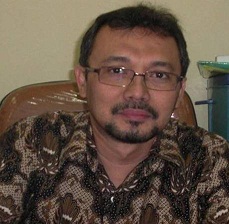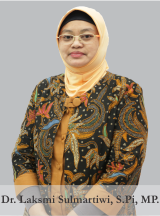Estimation of Sources and Marine Debris Dynamics Movement along the Coast of Sukajaya Lempasing Village, Lampung Province
Downloads
The coastal zone is a transitional area characterized by complex dynamics influenced by the interaction between land and sea. One of the consequences of this interaction is the accumulation of solid pollutants in the form of waste, which has the potential to disrupt the surrounding ecosystem's balance. This study aims to estimate the origin and movement pathways of marine debris along the coast of Sukajaya Lempasing Village by analyzing surface current patterns. The methods applied include purposive sampling and both quantitative and qualitative descriptive analysis. Waste data collection followed the guidelines issued by the Ministry of Marine Affairs and Fisheries in 2024, while surface current simulations were conducted using MIKE 21 with the Flow Model Flexible Mesh module. Monitoring results indicated that plastic waste dominated at all stations, with the highest number recorded at Station 1 (671 items), which also had the greatest total waste weight, amounting to 38.5 kg. The average waste density in the study area was 4.82 pcs/m². Surface current speeds ranged from 0.004 to 0.008 m/s on March 28, 2024, and from 0.005 to 0.015 m/s on April 2, 2024. Based on modeling results and interviews with local residents, the primary source of the waste was river discharge, which was then transported by longshore currents and subsequently accumulated along the coast of Sukajaya Lempasing Village.
Ballesteros, V. L., Matthews, J. L., & Hoeksema, B. W. (2018). Pollution and coral damage caused by derelict fishing gear on coral reefs around Koh Tao, Gulf of Thailand. Marine Pollution Bulletin, 135:1107-1116. https://doi.org/10.1016/j.marpolbul.2018.08.033
Barnes, D. K. A. (2005). Remote islands reveal rapid rise of Southern Hemisphere Sea debris. The Scientific World, 5:915-921. https://doi.org/10.1100/tsw.2005.120
Budiwicaksono, A. R., Subardjo, P., & Novico, F. (2013). Pemodelan pola arus pada tiga kondisi musim berbeda sebagai jalur pelayaran Perairan Teluk Lampung menggunakan Software Delft3D. Jurnal Oseanografi, 2(3):280-292. http://ejournal-s1.undip.ac.id/index.php/jose
Chatting, M., Al-Maslamani, I., Walton, M., Skov, M. W., Kennedy, H., Husrevoglu, Y. S., & Le Vay, L. (2022). Future mangrove carbon storage under climate change and deforestation. Frontiers in Marine Science, 9(781876):1-14. https://doi.org/10.3389/fmars.2022.781876
Cordova, M. R., & Nurhati, I. S. (2019). Major sources and monthly variations in the release of land-derived marine debris from the Greater Jakarta area, Indonesia. Scientific Reports, 9(18730):1-9. https://doi.org/10.1038/s41598-019-55065-2
Djaguna, A., Pelle, W. E., Schaduw, J. N., Manengkey, H. W., Rumampuk, N. D., & Ngangi, E. LA. (2019). Identifikasi sampah laut di Pantai Tongkaina dan Talawaan Bajo. Jurnal Pesisir dan Laut Tropis, 7(3):174-182.
Gall, S. C., & Thompson, R. C. (2015). The impact of debris on marine life. Marine Pollution Bulletin, 92(1–2):170-179. https://doi.org/10.1016/j.marpolbul.2014.12.041
Gülenç, Z., Konaklı, D., & Öztürk, İ. D. (2020). Raising awareness about marine litter through beach cleanup activities along the Turkish coasts of the Black Sea. Marine Litter, 56:74-81.
Gwada, B., Ogendi, G., Makindi, S. M., & Trott, S. (2019). Composition of plastic waste discarded by households and its management approaches. Global Journal of Environmental Science and Management, 5(1):83-94. https://doi.org/10.22034/gjesm.2019.01.07
Hamilton, S. E., & Friess, D. A. (2018). Global carbon stocks and potential emissions due to mangrove deforestation from 2000 to 2012. Nature Climate Change, 8(3):240-244. https://doi.org/10.1038/s41558-018-0090-4
Jambeck, J. R., Geyer, R., Wilcox, C., Siegler, T. R., Perryman, M., Andrady, A., Narayan, R., & Law, K. L. (2015). Plastic waste inputs from land into the ocean. Science, 347(6223):768-771. https://doi.org/10.1126/science.1260352
Jang, Y. C., Lee, J., Hong, S., Lee, J. S., Shim, W. J., & Song, Y. K. (2014). Sources of plastic marine debris on beaches of Korea: More from the ocean than the land. Ocean Science Journal, 49(2):151-162. https://doi.org/10.1007/s12601-014-0015-8
Kementerian Kelautan dan Perikanan. (2024). Pedoman teknis monitoring sampah laut tahun 2024. Jakarta: Kementerian Kelautan dan Perikanan.
Kurnia, A., Maharani, H. W., & Delis, P. C. (2024). Identification of types and weight of marine debris in each season at Ancol Gen Beach, Pesawahan, Teluk Betung Selatan, Bandar Lampung. Jurnal Ilmiah PLATAX, 12(1):171-176. https://doi.org/10.35800/jip.v12i1.53553
Kusuma, A. H., Efendi, E., & Mayagues, H. (2022). Identifikasi sampah anorganik di Desa Gebang, Kecamatan Teluk Pandan, Kabupaten Pesawaran, Provinsi Lampung. Jurnal Perikanan Unram, 12(4):575-587. https://doi.org/10.29303/jp.v12i4.370
Lenaini, I. (2021). Teknik pengambilan sampel purposive dan snowball sampling. Historis: Jurnal Kajian, Penelitian dan Pengambangan Pendidikan Sejarah, 6(1):33-39. https://doi.org/10.31764/historis.vXiY.4075
Lima, M. do A. C., Bergamo, T. F., Ward, R. D., & Joyce, C. B. (2023). A review of seagrass ecosystem services: providing nature-based solutions for a changing world. Hydrobiologia, 850(12–13):2655-2670. https://doi.org/10.1007/s10750-023-05244-0
Malone, T. C., & Newton, A. (2020). The globalization of cultural eutrophication in the coastal ocean: Causes and consequences. Frontiers in Marine Science, 7(670):1-30. https://doi.org/10.3389/fmars.2020.00670
Niaounakis, M. (2017). Management of marine plastic debris. Matthew Deans.
Obbard, R. W., Sadri, S., Wong, Y. Q., Khitun, A. A., Baker, I., & Thompson, R. C. (2014). Global warming releases microplastic legacy frozen in Arctic Sea ice. Earth’s Future, 2(6)315-320. https://doi.org/10.1002/2014EF000
Saputra, V. H., Rifai, A., & Kunarso. (2017). Variabilitas musiman pola arus di perairan Surabaya Jawa Timur. Jurnal Oseanografi, 6(3):439-448. http://ejournal-s1.undip.ac.id/index.php/joseDiponegoroJl.Prof.Sudarto,SHTembalangTlp./Fax.
Sari, N. K., Yuniar, D., & Alam, F. C. (2023). Exploring marine surface microplastic around Pasaran Island, Lampung Province. IOP Conference Series: Earth and Environmental Science, 1239(012033)1-10. https://doi.org/10.1088/1755-1315/1239/1/012033
Satiyarti, R. B., Wulan Pawhestri, S., & Adila, I. S. (2022). Identifikasi mikroplastik pada sedimen Pantai Sukaraja, Lampung. Jurnal Kelautan Tropis, 25(3):329-336. https://doi.org/10.14710/jkt.v25i3.12786
Sheavly, S. B., & Register, K. M. (2007). Marine debris and plastics: Environmental concerns, sources, impacts and solutions. Journal of Polymers and the Environment, 15(4):301-305. https://doi.org/10.1007/s10924-007-0074-3
Sofwatillah, Risnita, Jailani, M. S., & Saksitha, D. A. (2024). Tehnik analisis data kuantitatif dan kualitatif dalam penelitian ilmiah. Journal Genta Mulia, 15(2):79-91. https://ejournal.stkipbbm.ac.id/index.php/gm
Syahri, Q. A., Mahfudz, A. A., Johan, Y., & Wulansari, N. Z. (2024). Analisis tipe pasang surut menggunakan metode admiralty (Studi kasus: Teluk Lampung). Prosiding Seminar Nasional Hasil Penelitian Kelautan dan Perikanan, 2:52-63. https://semnas.bpfp-unib.com/index.php/semnaskel/article/view/232/159
Unger, A., & Harrison, N. (2016). Fisheries as a source of marine debris on beaches in the United Kingdom. Marine Pollution Bulletin, 107(1):52-58.
https://doi.org/10.1016/j.marpolbul.2016.04.024
Williamson, P., & Guinder, V. A. (2021). Effect of climate change on marine ecosystems. The impacts of climate change, 2021:115-176. https://doi.org/10.1016/B978-0-12-822373-4.00024-0
Wisha, U. J., Husrin, S., & Prihantono, J. (2015). Hydrodynamics Banten Bay during transitional seasons (August-September). Ilmu Kelautan: Indonesian Journal of Marine Sciences, 20(2):101-112. https://doi.org/10.14710/ik.ijms.20.2.101-112
Woodall, L. C., Sanchez-Vidal, A., Canals, M., Paterson, G. L. J., Coppock, R., Sleight, V., Calafat, A., Rogers, A. D., Narayanaswamy, B. E., & Thompson, R. C. (2014). The deep sea is a major sink for microplastic debris. Royal Society Open Science, 1(140317):1-8. https://doi.org/10.1098/rsos.140317
Copyright (c) 2025 Journal of Marine and Coastal Science

This work is licensed under a Creative Commons Attribution-NonCommercial-ShareAlike 4.0 International License.













